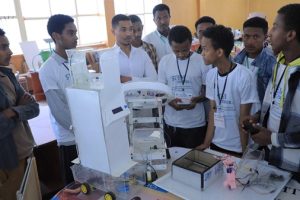
According to a recent statement of the United Nations Higher Commission for Refugees (UNHCR) Ethiopia is hosting over 735,200 refugees currently and the number is expected to grow to 752 thousand by the end of this year. Only in 2019, over 96,700 refugees have arrived in Ethiopia.
The refugees in Ethiopia are from 26 countries forced to flee insecurity, political instability, conflict, forced military conscription, conflict-induced famine and other problems in their countries of origin. According to UNHCR these refugees are accommodated in 26 refugee camps across six regional states.
Sadly, the six regional states which hosted this huge number of refugees are under developed with their own socio-economic and climatological challenges struggling to withdraw from poverty.
It’s clear that this additional number of population to these states with their-own socio-economic and climatological challenges affects the overall development of the host community and may back their struggle for poverty, if not managed properly with serious integrated interventions of the international community.
Not only that these hundreds of thousands refugees are forced for camp life and their survival is dependent on governmental and non-governmental aid provisions which is only life-saving assistance.
Deputy Director General, Agency for Refugees and Returnees Affairs (ARRA) of Ethiopia, Addisu Kebenessa said that Ethiopia is providing physical protection, shelter (camp), health and education services. Since protecting of refugees is a shared responsibility, Ethiopia is providing the services with the international community cooperatively.
Addisu stated that the refugees are forced to push camp life and their life is dependent to aid and the host community is also contributing a lot like land and water. This means the camp life is affecting both the host community and the refugees.
Although Ethiopia has accepted refugees since the 7th century and was hosted a lot of refugees even without any international law, Ethiopia has amended its refugee law last year to guarantee more rights for the refugees, Addisu told The Ethiopian Herald.
For him the new refugee law provides additional rights for refugees like the right for access to job opportunity, the right to movement and to live out of camps, the right to a resident permit and registration of their vital events in addition to the social services like access to education, healthcare and humanitarian aid.
Meanwhile, Addisu said that a two year pilot test program is launched jointly with the World Bank to implement the new law mainly focusing on job creation for the refugees and host communities inclusively. For the proper implementation of the job creation plan, preparation was finalized during the past six months and selection of persons’ forms for both the host community and refugees will start by next month, he added.
After selection, job creation training will start immediately, he said adding that the selected one’s will join to job in different fields mainly in agriculture. Addisu stated that land is preparing jointly with the regional states.
Hence, the next two years refugee operation will focus on development actions mainly job creation and providing the usual services, the deputy director argued. He added that this new effort will help for the inclusion of refugees and the host communities and for the self-reliance of refugees which needs strong integration, commitment and participation of the international community.
Meanwhile, last Friday Ethiopia and UNHCR has launched a two-year Ethiopia Country Refugee Response Plan mainly to ensure the coherence and alignment of planned interventions of supporting the refugees and for the smooth humanitarian aid.
UNHCR Spokesperson Kisut Gebregziabher told The Ethiopian Herald that since the number of refugees is increasing from time to time it’s time for collective action to solve the refugee problems. He noted that the two year plan aims boosting the humanitarian aid and facilitating development operations focusing protection, education, energy and environment, food and nutrition, health, WASH, livelihood and shelter.
For him, the plan is the collective response of 57 humanitarian and development agencies in support of all registered refugee population in Ethiopia and will focus mainly on for the self-reliance and inclusion of refugees.
The response effort will be guided by a comprehensive protection and solutions strategy and aims to provide protection and multi-sectorial assistance to refugees, in addition to targeted support to their host communities. This will mainly to seek innovative, cost effective and sustainable ways to deliver basic needs and essential services including life-saving assistance, the plan stated.
Kisut said that the combined financial requirement for the two year plan is over 658 million USD. This shows that it needs strong commitment of the international community to meet the goal. Since the international aid agencies are working here in this global climate of limited humanitarian and development financing, it may be difficult to get this amount, but the partners participated during the launching ceremony are committed and shows their support to the program, he added.
The Ethiopian herald February 1/2020
BY DARGIE KAHSAY





